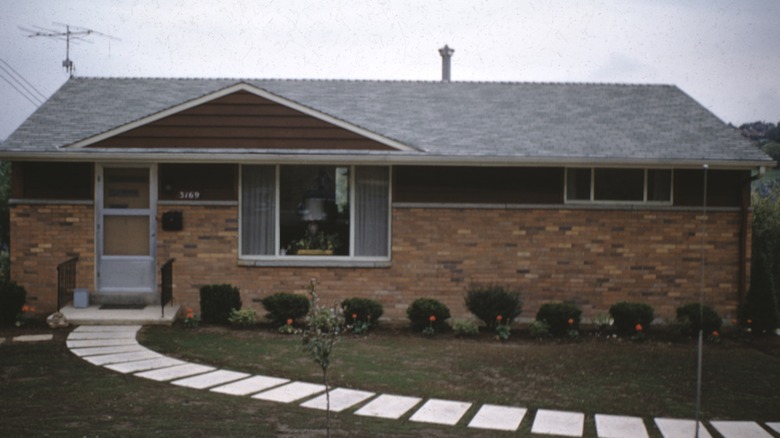What HGTV Stars Ben & Erin Napier Want You To Know Before Demo Day
Ben and Erin Napier have no shortage of experience when it comes to transforming historic houses into modern-day dream homes. With Erin Napier's eye for design and Ben Napier's woodworking skill, the dynamic duo behind HGTV's "Home Town" has shown fans that even the oldest most disastrous homes are full of revitalization potential. On the hit HGTV series, it's not uncommon to see the Napiers and their crew donning safety goggles and gloves and taking a sledgehammer to walls, as their projects often require some heavy demotion work before the new designs can come to life. But, before you knock down a wall and attempt a demo DIY, there's an important lesson home renovators can learn from Ben and Erin Napier — not all homes are equally easy to renovate.
On Season 8, Episode 5 of "Home Town," Erin and Ben Napier provided viewers with a valuable lesson about homes built in the 1960s – they are notoriously difficult to demo. While working on the demo for a one-level 1960s ranch-style house, Erin shared, "I guarantee it's gonna be a nightmare." Adding, "It's an exceptional one, most are not this involved." As predicted, the Napiers' demo for the 1960s brick home was a multi-day ordeal as their team took the house down to the studs. But, why exactly are 1960s abodes so troublesome to demo? Below, we're breaking down the simple answer to this question and sharing important things you need to know before you break out the power tools for demo day.
Why 1960s ranch-style homes are so hard to demo
If you own, or are hoping to buy and renovate a 1960s home like the one featured on Season 8, Episode 5 of HGTV's "Home Town," you may want to consider that these homes might be much tougher to demo than ones from other eras. The reason lies in the sturdy construction of these homes. "You know how these houses from the sixties are. It's like a brick box with a bunch of plywood wedged into it," said Ben Napier. "This demo is one that just goes on and on and on." Because the Napiers wanted to opt for a more contemporary-friendly open-concept floor plan, the demo required them to take the home's interior down to the studs and reframe. The couple likened the home to a bunker and Erin Napier noted that "you cannot dismantle these things" without significant effort.
Like Ben and Erin Napier, you may find yourself demolishing a large number of walls, outdated bathrooms, and old fireplaces, and taking a 1960s home down to the studs before you can modernize and create an open-concept floor plan. With the average cost to demolish a 2,000-square-foot house hovering around $15,000 (per Angi), this is no easy endeavor. Also, homes built in this era are typically constructed using outdated and potentially harmful materials, including asbestos and lead-based paint. Since these materials are considered hazards, they can require specialized removal and disposal, adding to the cost and time needed for the demo.
Drive down demo costs
Thankfully, there are many tips and hacks that will make for easier home demolition, even for pesky 1960s brick builds. First, we recommend that, like Ben and Erin Napier do for their HGTV projects, you enlist a team of experts to help you demolish safely and get things right the first time. The Napiers' team of demolishers and carpenters knew it was necessary to take the house down to the studs to install new sheetrock and bring Erin Napier's design to life. If you don't have expertise in architecture or carpentry, enlisting experts is key. It might be costly upfront, but the professionals typically know which demo projects you'll need permits for and can help you apply for them. And, they can keep you safe from major mistakes like exposing live wires and tearing down load-bearing beams on your ceiling.
Also, as the Napiers do on "Home Town," you may opt to make your demolition cheaper and easier by minimizing the number of layout changes you make to your home. In some episodes, Ben and Erin Napier have chosen to make minimal demolition changes to the existing structure of a home, or have only made smaller structural changes like removing a hallway closet to expand a bathroom's space. Foregoing major structural work and making simpler cosmetic upgrades and small changes to make your home feel more luxurious is a surefire way to significantly drive down the cost and time associated with your demo.


